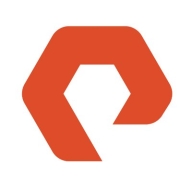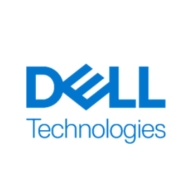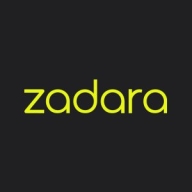


Zadara and Dell PowerMax compete in the enterprise storage solutions category. Based on user reviews, Dell PowerMax seems to have the upper hand due to its superior performance and reliability.
Features: Zadara excels in flexibility, particularly in cloud integration and managed services, offering scalable storage solutions with comprehensive cloud vendor support. Dell PowerMax stands out for its impressive performance, featuring NVMe technology and REST API for seamless data management. Its data reduction capabilities are highly efficient, making it a preferred choice for those seeking high-speed operations.
Room for Improvement: Zadara users seek faster updates and better reporting tools, particularly improvements in VMware and iSCSI systems. They also desire a more refined management interface. Dell PowerMax users want better NVMe support and cost efficiency, expressing the need for improved management tools and smoother cloud service integration.
Ease of Deployment and Customer Service: Zadara is noted for easy deployment across hybrid and public clouds, supported by reliable 24/7 customer service. It simplifies operations for companies preferring hosted solutions. Dell PowerMax offers strong vendor support and efficient issue resolution, though its deployment is more complex, mainly due to its on-premises nature, which benefits from extensive vendor backing.
Pricing and ROI: Zadara offers a straightforward pricing model with predictable pay-as-you-go structures, which facilitates cost-effective scaling, although some regional pricing challenges exist. Dell PowerMax is considered a premium solution with significant upfront costs, but users find its pricing competitive in the long run due to its high performance and comprehensive global agreements.
By opting for the gold subscription every three years, you get a free upgrade to the latest controller release.
If you wait more than seven years to buy another one, you get a return on your investment.
During a DCDR setup and migration from VMAX to Dell PowerMax, what was planned as a two-day downtime was completed in just three to four hours.
The performance metrics or benchmarks I use to measure success with Dell PowerMax include uptime as well as our response times on our platforms, both of which are exactly where we want them to be, which is five nines and as fast as possible.
My client has seen significant ROI since the install, and when you don't go down, that's an ROI in and of itself.
The cost is not cheaper compared to AWS, and we have not seen the expected return on investment.
We also had one outage where a controller of one of the products had failed and had to be replaced on-site.
Customers always have their issues resolved promptly.
Pure has good storage.
I would rate Dell PowerMax support as a ten, as I have never had an issue with Dell support as it relates to this product.
Dell support for Dell PowerMax is exceptional, rating a perfect 10 out of 10.
I evaluate Dell's support for PowerMax as very good, especially regarding their response time as well as their willingness to get ahead of issues.
We lack adequate response times and a 24/7 service level agreement.
I rate the technical support from Zadara as nine out of ten.
It is highly scalable.
It is suitable for both medium-sized and enterprise businesses.
It hasn't broken down anytime in the last six to seven years, despite hurricanes, earthquakes, and power outages.
Scalability is not an issue.
Dell PowerMax is good for enterprises, and it also depends on how much workload you're going to bring in on Dell PowerMax in terms of performance and how many users are going to use the database you're hosting.
Volumes can be defined to grow to any level without impacting overall performance.
Zadara is a fully-fledged platform, and our customers are happy with its use.
During the eight years, there have been no problems such as hardware failure or stopping.
I would rate the stability of the solution as a ten out of ten.
I would rate the stability of the product at seven out of ten.
These patches can be applied on the fly without requiring software upgrades or system downtime.
I would rate it nine out of ten since there are no required downtimes, even during firmware upgrades.
There has been no downtime with Dell PowerMax; it's been extremely reliable, easy to manage, easy to upgrade, and trustworthy as we've upgraded over the years from one version to another.
We would appreciate a built-in transparent failover in the next release to eliminate the need for a separate metro cluster.
I'm eagerly anticipating the roadmap's promise of introducing multiple controllers, which could significantly boost scalability and resilience.
We mostly rely on long-term releases. We don't need the most up-to-date features, but we need a reliable environment.
Compared to competitors such as NetApp, which integrates with public cloud hyperscalers (GCP, Azure, AWS), Dell PowerMax lacks in this aspect.
Dell can assist by providing plug-and-play integrated templates that allow customers to drag, drop, modify, and connect with any target system for generating snapshots without logging into the storage directly.
Dell PowerMax NVMe is very reliable storage and cannot experience downtime.
Adding AI capabilities could enhance the offering as well.
Maintenance can also be complicated, especially when deeper troubleshooting requires navigating the CLI and searching for logs.
While the prices may be higher than those of other vendors, we see it as a market leader with benefits.
The support can be a bit pricey, but the solution is more cost-effective than anything else out there.
I would give it a nine out of ten in terms of costliness.
The higher cost compared to other vendors is justified by additional features, vendor-managed upgrades, and superior support services.
It is the best choice for large projects in terms of price and features compared to midrange solutions.
The price is starting from $500,000.
The pricing is considered expensive.
Pure Storage has signature security technology, which cannot be deleted, even if you are an administrator.
The platform's robust features include excellent sustainability tracking, and a comprehensive dashboard offering insights into IOPS, bandwidth, performance, and virtual activities.
Its data compression feature is the best that we have ever seen.
NVMe provides additional fast cache, similar to random access memory (RAM), which improves overall system performance and read/write experience for users.
Dell PowerMax NVMe is very supportive of our operational growth since we require daily performance from our core banking systems and need to facilitate data movement efficiently.
The key benefits of using Dell PowerMax, quantified in terms of saved hours and saved costs, is having one single platform that provides functionality to all of our internal customers.
The most valuable feature is its storage management capability.
Zadara's troubleshooting feature is very valuable for me.



Pure Storage FlashArray//X is the world’s first enterprise-class, all-NVMe flash storage array. It represents a new class of storage – shared accelerated storage, which is a term coined by Gartner – that delivers major breakthroughs in performance, simplicity, and consolidation.
Dell PowerMax offers robust performance, reliability, and efficient data handling. It is recognized for its compression, deduplication, and NVMe technology, significantly benefiting data centers with its advanced replication and uptime.
PowerMax is equipped to handle mission-critical applications, providing impressive performance metrics with low latency and high IOPS capacity. Its CloudIQ and Unisphere interfaces enhance manageability, while REST API support simplifies storage management. Users in sectors like healthcare, finance, and telecommunications leverage its capabilities for database management, high-transaction block storage, and disaster recovery. However, opportunities for improving deduplication efficiency, interface complexity, and automation remain.
What are the key features of Dell PowerMax?Industries utilize Dell PowerMax to support diverse environments like VMware, Oracle, and PostgreSQL. It serves multiple sectors such as healthcare, finance, and government, aiding in data storage consolidation, disaster recovery, and high-availability hosting for critical systems and applications.
Zadara is a powerful enterprise-level storage solution whose design enables it to handle every aspect of a user’s data storage needs. It can be deployed in any location, using any protocol, and storing any data type that an organization requires. With Zadara, organizations can do everything that they were able to do with more traditional systems in a cheaper and more efficient way.
Zadara Benefits
Some of the ways that organizations can benefit by choosing to deploy Zadara include:
Zadara Features
File analytics. Organizations can leverage a powerful analytics package that can provide them with critical insights. These tools can help users sort through their data and make more informed data management decisions.
Reviews from Real Users
Zadara is a highly effective solution that stands out when compared to many of its competitors. Two major advantages it offers are its extensive suite of cloud solution integrations and its object storage capability.
Steve H., the chief technology officer at Pratum, writes, “One of the most valuable features is its integration with other cloud solutions. We have a presence within Amazon EC2 and we leverage computer instances there. Being able to integrate with computing, both locally within Zadara, as well as with other cloud vendors such as Amazon, is very helpful, while also being able to maintain extremely low latency between those connections.”
Mauro R., the CEO of Momit SRL, says, “The object storage feature is wonderful. With traditional storage, you have a cost per gigabyte that is extremely high or related to the number of disks. With Zadara Storage Cloud, you have a cost per gigabyte that you can cut and tailor to your needs independent of the number or size of the disks.”
We monitor all All-Flash Storage reviews to prevent fraudulent reviews and keep review quality high. We do not post reviews by company employees or direct competitors. We validate each review for authenticity via cross-reference with LinkedIn, and personal follow-up with the reviewer when necessary.